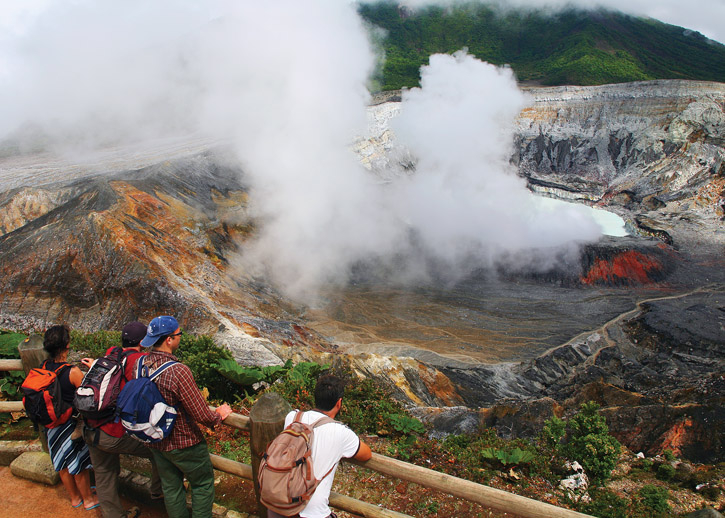Costa Rica lies at the heart of one of the most active volcanic regions on earth and is home to 7 of the isthmus’s 42 active volcanoes, plus 60 dormant or extinct ones. Some have the look classically associated with volcanoes—a graceful symmetrical cone rising to a single crater. Others are sprawling, weathered mountains whose once-noble summits have collapsed into huge depressions called calderas (from the Portuguese word for “cauldron”).

The water in the Diego de la Heya crater of Volcán Irazú can range from pea-green to rust-red. Photo © Ben Haeringer, licensed Creative Commons Attribution No-Derivatives.
Volcán Poás has been particularly violent during the past 30 years.In 1963 Volcán Irazú (3,412 meters/11,194 feet) broke a 20-year silence, disgorging great clouds of smoke and ash. The eruptions triggered a bizarre storm that showered San José with 13 centimeters (5 inches) of muddy ash, snuffing out the 1964 coffee crop but enriching the soil of the Meseta Central for years to come. The eruption lasted for two years, then abruptly ceased.Volcán Poás (2,692 meters/8,832 feet) has been particularly violent during the past 30 years. In the 1950s the restless 6.5-kilometer-wide (4-mile-wide) giant awoke with a roar after a 60-year snooze, and it has been huffing and puffing ever since. Eruptions then kicked up a new cone about 100 meters (330 feet) tall. Two of Poás’s craters now slumber under blankets of vegetation (one even cradles a lake), but the third crater belches and bubbles persistently.

Poás Volcano National Park, Costa Rica’s most visited national park, stars an active volcano. Photo © Christopher P. Baker.
Volcán Arenal (1,624 meters/5,328 feet) gives a more spectacular light-and-sound show. After a four-century-long Rip van Winkle-like dormancy, this 4,000-year-old juvenile began spouting in 1968, when it laid waste to a 10-square-kilometer (4-square-mile) area. Arenal’s activity, sometimes minor and sometimes not, continues unabated; it erupted spectacularly in August 2000, killing two people, and then delivered small eruptions virtually daily until 2010, when it suddenly stopped spewing. In 2013 it awoke from slumber again, as did Volcán Turrialba, which at press time had sustained stop-and-go eruptions resulting in several evacuations of local inhabitants.
Several national parks have been created around active volcanoes. Atop Poás’s crater rim, for example, you can gape down into the great well-like vent and see pools of molten lava bubbling menacingly, giving off diabolical fumes and emitting explosive cracks, like the sound of distant artillery.
Excerpted from the Tenth Edition of Moon Costa Rica.